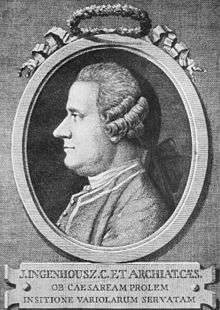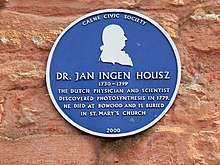Jan Ingenhousz
Jan (or John) Ingenhousz or Ingen-Housz FRS (8 December 1730 – 7 September 1799) was a Dutch physiologist, biologist and chemist.
Jan Ingenhousz | |
|---|---|
 | |
| Born | 8 December 1730 |
| Died | 7 September 1799 (aged 68) Calne, Wiltshire, Great Britain |
| Nationality | Dutch |
| Alma mater | Catholic University of Leuven |
| Known for | Photosynthesis |
| Scientific career | |
| Fields | Physiology |
| Influences | Pieter van Musschenbroek David Gaub |
He is best known for discovering photosynthesis by showing that light is essential to the process by which green plants absorb carbon dioxide and release oxygen.[1][2][3] He also discovered that plants, like animals, have cellular respiration.[4] In his lifetime he was known for successfully inoculating the members of the Habsburg family in Vienna against smallpox in 1768 and subsequently being the private counsellor and personal physician to the Austrian Empress Maria Theresa.[5]
Early life
He was born into the patrician Ingen Housz family in Breda in Staats-Brabant in the Dutch Republic. From the age of 16, Ingenhousz studied medicine at the University of Leuven, where he obtained his MD in 1753. He studied two more years at the University of Leiden, where he attended lectures by, among others, Pieter van Musschenbroek, which led Ingenhousz to have a lifelong interest in electricity. In 1755 he returned home to Breda, where he started a general medical practice.
Work with smallpox
Following his father's death in July 1764, Ingenhousz intended to travel through Europe for study, starting in England where he wanted to learn the latest techniques in inoculation against smallpox. Via the physician John Pringle, who had been a family friend since the 1740s, he quickly made many valuable contacts in London, and in due time became a master inoculator. In 1767, he inoculated 700 village people in a successful effort to combat an epidemic in Hertfordshire. In 1768, Empress Maria Theresa read a letter by Pringle on the success in the fight against smallpox in England, whereas in the Austrian empire the medical establishment vehemently opposed inoculations. She decided to have her own family inoculated first (a cousin had already died), and requested help via the English royal house. On Pringle's recommendation, Ingenhousz was selected and requested to travel to Austria. He had planned to inoculate the Royal Family by pricking them with a needle and thread that were coated with smallpox germs taken from the pus of a smallpox-infected person. The idea of the inoculation was that by giving a few germs to a healthy body the body would develop immunisation from smallpox. The inoculation was a success and he became Maria Theresa's court physician. He settled in Vienna, where in 1775 he married Agatha Maria Jacquin.
Work with photosynthesis
In the 1770s Ingenhousz became interested in gaseous exchanges of plants. He did this after meeting the scientist Joseph Priestley (1733–1804) at his house in Birstall, West Yorkshire, on 23 May 1771. Priestley had found out that plants make and absorb gases. Ingenhousz' travelling party in northern England included Benjamin Franklin. They then stayed at the rectory in Thornhill, Yorkshire with the polymath and botanist Rev. John Michell. In 1779, Ingenhousz discovered that, in the presence of light, plants give off bubbles from their green parts while, in the shade, the bubbles eventually stop.[6] He identified the gas as oxygen. He also discovered that, in the dark, plants give off carbon dioxide. He realised as well that the amount of oxygen given off in the light is more than the amount of carbon dioxide given off in the dark. This demonstrated that some of the mass of plants comes from the air, and not only the water and nutrients in the soil.
Other work

In addition to his work in the Netherlands and Vienna, Ingenhousz spent time in France, England, Scotland, and Switzerland, among other places. He carried out research in electricity, heat conduction, and chemistry, and was in close and frequent correspondence with both Benjamin Franklin and Henry Cavendish.[7] In 1785, he described the irregular movement of coal dust on the surface of alcohol and therefore has a claim as discoverer of what came to be known as Brownian motion. Ingenhousz was elected a Fellow of the Royal Society of London in 1769. In 1799, Ingenhousz died at Bowood House, Calne, England, and was buried in the churchyard of St Mary the Virgin, Calne. His wife died the following year.[8]
Tribute
On 8 December 2017, Google Doodle commemorated his 287th birthday.[9]
References
- Beale and Beale, Echoes of Ingen Housz, 2011
- Gest, Howard (2000). "Bicentenary homage to Dr Jan Ingen-Housz, MD (1730–1799), pioneer of photosynthesis research". Photosynthesis Research. 63 (2): 183–90. doi:10.1023/A:1006460024843. PMID 16228428.
- Geerd Magiels, Dr. Jan Ingenhousz, or why don't we know who discovered photosynthesis, 1st Conference of the European Philosophy of Science Association 2007
- Howard Gest (1997). "A 'misplaced chapter' in the history of photosynthesis research; the second publication (1796) on plant processes by Dr Jan Ingen-Housz, MD, discoverer of photosynthesis. A bicentenniel 'resurrection'" (PDF). Photosynthesis Research. 53: 65–72. doi:10.1023/A:1005827711469.
- Ingen Housz JM, Beale N, Beale E (2005). "The life of Dr Jan Ingen Housz (1730–99), private counsellor and personal physician to Emperor Joseph II of Austria". J Med Biogr. 13 (1): 15–21. PMID 15682228.
- Jan Ingenhousz, Experiments upon Vegetables, Discovering Their great Power of purifying the Common Air in the Sun-shine, and of Injuring it in the Shade and at Night. To Which is Joined, A new Method of examining the accurate Degree of Salubrity of the Atmosphere, London, 1779. From Henry Marshall Leicester and Herbert S. Klickstein, A Source Book in Chemistry 1400–1900, New York, NY: McGraw Hill, 1952. Excerpts. Retrieved 24 June 2008.
- Smith, Edgar F. (1926). "Forgotten Chemists". Journal of Chemical Education. 3: 29–40. Bibcode:1926JChEd...3...29S. doi:10.1021/ed003p29. Archived from the original on 30 June 2012.
-
- Van Klooster; H. S. (1952). "Jan Ingenhousz". Journal of Chemical Education. 29 (7): 353–355. Bibcode:1952JChEd..29..353V. doi:10.1021/ed029p353. Archived from the original on 12 January 2013.
- "Jan Ingenhousz's 287th Birthday". Google.com. 8 December 2017.
Further reading
- Norman and Elaine Beale, Echoes of Ingen Housz. The long lost story of the genius who rescued the Habsburgs from smallpox and became the father of photosynthesis. 630 pages, with a foreword by David Bellamy, Hobnob Press, July 2011, ISBN 1-906978-14-X.
- Geerdt Magiels, From sunlight to insight. Jan IngenHousz, the discovery of photosynthesis & science in the light of ecology. VUB Press, 2009, ISBN 978-90-5487-645-8.
- Beaudreau, Sherry Ann; Finger Stanley (2006). "Medical electricity and madness in the 18th century: the legacies of Benjamin Franklin and Jan Ingenhousz". Perspect. Biol. Med. United States. 49 (3): 330–45. doi:10.1353/pbm.2006.0036. ISSN 0031-5982. PMID 16960304.
- Smit, P. (1980). "Jan Ingen-Housz (1730–1799): some new evidence about his life and work". Janus. Netherlands. 67 (1–2–3): 125–39. ISSN 0021-4264. PMID 11610754.
External links
| Wikimedia Commons has media related to Jan Ingenhousz. |